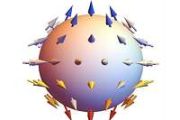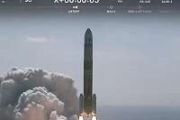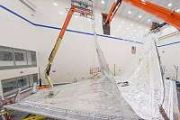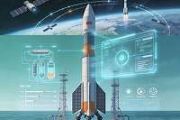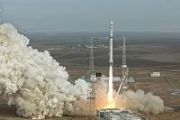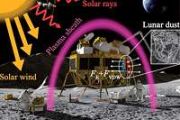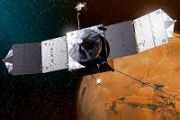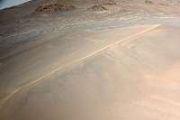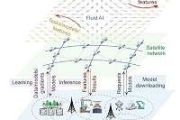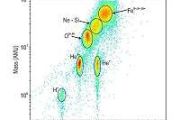
Copernical Team
Enigmatic Rock Layer in Mars' Gale Crater Awaits Measurements by the Curiosity Rover
 Scientists have been studying the sediments within Mars' Gale crater for many years using orbital data sets, but thanks to the Curiosity rover driving across these deposits we can also obtain up-close observations and detailed measurements of the rocks, similar to field work done by geologists on Earth.
A new paper led by Planetary Science Institute Senior Scientist Catherine Weitz takes a
Scientists have been studying the sediments within Mars' Gale crater for many years using orbital data sets, but thanks to the Curiosity rover driving across these deposits we can also obtain up-close observations and detailed measurements of the rocks, similar to field work done by geologists on Earth.
A new paper led by Planetary Science Institute Senior Scientist Catherine Weitz takes a Revenge of the Wheels Sol 3458
 While angular, pointy rocks have damaged the rover's wheels since early in the MSL mission, sometimes the wheels damage rocks as the rover drives over them. As seen especially at the upper left side of this image, the bedrock was scraped and fractured by the rover during the Sol 3456 drive.
Unfortunately, that drive did not complete as planned, but the tactical team took advantage of the s
While angular, pointy rocks have damaged the rover's wheels since early in the MSL mission, sometimes the wheels damage rocks as the rover drives over them. As seen especially at the upper left side of this image, the bedrock was scraped and fractured by the rover during the Sol 3456 drive.
Unfortunately, that drive did not complete as planned, but the tactical team took advantage of the s Discovery of 30 exocomets in a young planetary system
 For the past thirty years, the star ss Pictoris has fascinated astronomers because it enables them to observe a planetary system in the process of formation. It is made up of at least two young planets, and also contains comets, which were detected as early as 1987.
These were the first comets ever observed around a star other than the Sun. Now, an international research team headed by Ala
For the past thirty years, the star ss Pictoris has fascinated astronomers because it enables them to observe a planetary system in the process of formation. It is made up of at least two young planets, and also contains comets, which were detected as early as 1987.
These were the first comets ever observed around a star other than the Sun. Now, an international research team headed by Ala AST SpaceMobile announces collaboration with Globe Telecom
 AST SpaceMobile, Inc. (NASDAQ: ASTS), the company building the first and only space-based cellular broadband network designed to be accessible directly by standard mobile phones, has announced a Memorandum of Understanding ("MoU") with Globe Telecom, Inc. ("Globe") (NASDAQ: GTMEF).
Globe is a leading digital platform in the Philippines, serving consumers and businesses' telecommunications
AST SpaceMobile, Inc. (NASDAQ: ASTS), the company building the first and only space-based cellular broadband network designed to be accessible directly by standard mobile phones, has announced a Memorandum of Understanding ("MoU") with Globe Telecom, Inc. ("Globe") (NASDAQ: GTMEF).
Globe is a leading digital platform in the Philippines, serving consumers and businesses' telecommunications HyPrSpace raises 1M euro in seed funding to develop reusable hybrid micro-launcher
 HyPrSpace, a startup specializing in the design of space launchers, has announced that it has raised euro 1.1 million from the Geodesic fund, the French Tech Seed fund managed on behalf of the French government by Bpifrance as part of France 2030, and private investors. This funding will allow the startup to strengthen its teams to accelerate the development of its OB-1 reusable launcher, and t
HyPrSpace, a startup specializing in the design of space launchers, has announced that it has raised euro 1.1 million from the Geodesic fund, the French Tech Seed fund managed on behalf of the French government by Bpifrance as part of France 2030, and private investors. This funding will allow the startup to strengthen its teams to accelerate the development of its OB-1 reusable launcher, and t Nanoavionics builds first nanosatellite for Promethee's EO constellation
 Satellite operator Promethee has contracted mission integrator NanoAvionics to build the first nanosatellite for the French company's planned constellation of Earth observation nanosatellites and image analysis platform. "ProtoMethee-1" will be based on NanoAvionics' flight-proven 16U nanosatellite bus M16P.
In addition to the satellite with onboard camera and propulsion, NanoAvionics will
Satellite operator Promethee has contracted mission integrator NanoAvionics to build the first nanosatellite for the French company's planned constellation of Earth observation nanosatellites and image analysis platform. "ProtoMethee-1" will be based on NanoAvionics' flight-proven 16U nanosatellite bus M16P.
In addition to the satellite with onboard camera and propulsion, NanoAvionics will Advanced Air Mobility Plans for Vertiports
 Looking forward to catching an air taxi? NASA is working to answer where Advanced Air Mobility or AAM vehicles will take off and land. Many AAM aircraft will be electric vertical takeoff and landing, or eVTOLs, so they will have the ability to take off and land vertically like helicopters on helipads. AAM vehicle types could also include other power and operating concepts.
NASA's Advanced
Looking forward to catching an air taxi? NASA is working to answer where Advanced Air Mobility or AAM vehicles will take off and land. Many AAM aircraft will be electric vertical takeoff and landing, or eVTOLs, so they will have the ability to take off and land vertically like helicopters on helipads. AAM vehicle types could also include other power and operating concepts.
NASA's Advanced NASA mentors students to achieve high performance in supercomputing competition
 Talented students from communities around the U.S. recently gained hands-on experience in high-performance computing, NASA style. With help from experts in the NASA Advanced Supercomputing (NAS) division at the agency's Ames Research Center in California's Silicon Valley, the students took part in a supercomputing competition. Twelve teams of undergraduate and graduate students from six Historic
Talented students from communities around the U.S. recently gained hands-on experience in high-performance computing, NASA style. With help from experts in the NASA Advanced Supercomputing (NAS) division at the agency's Ames Research Center in California's Silicon Valley, the students took part in a supercomputing competition. Twelve teams of undergraduate and graduate students from six Historic Satellogic and Geollect to provide geospatial insights for the maritime domain
 Satellogic Inc. (NASDAQ: SATL), a leader in sub-meter resolution satellite imagery collection, has entered into a teaming agreement with Geollect, a world leading geospatial intelligence and data analysis company, to offer unrivalled maritime domain awareness capabilities.
Satellogic will contribute its maritime imagery collection and processing capabilities to Geollect, which will lead th
Satellogic Inc. (NASDAQ: SATL), a leader in sub-meter resolution satellite imagery collection, has entered into a teaming agreement with Geollect, a world leading geospatial intelligence and data analysis company, to offer unrivalled maritime domain awareness capabilities.
Satellogic will contribute its maritime imagery collection and processing capabilities to Geollect, which will lead th AFRL is developing green power for satellites
 The Air Force Research Laboratory, or AFRL, Space Vehicles Directorate is developing a new "green energy" fuel cell technology, that will allow thruster equipped spacecraft to convert chemical energy in its bipropellant into electrical power.
This technology, called BEEPS for Bipropellant Enabled Electrical Power Supply, is being developed by a three-year Seedlings for Disruptive Capabilit
The Air Force Research Laboratory, or AFRL, Space Vehicles Directorate is developing a new "green energy" fuel cell technology, that will allow thruster equipped spacecraft to convert chemical energy in its bipropellant into electrical power.
This technology, called BEEPS for Bipropellant Enabled Electrical Power Supply, is being developed by a three-year Seedlings for Disruptive Capabilit 
